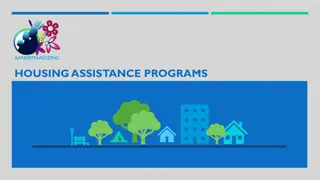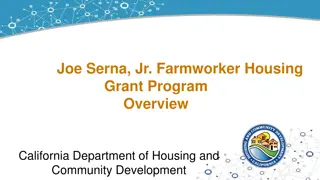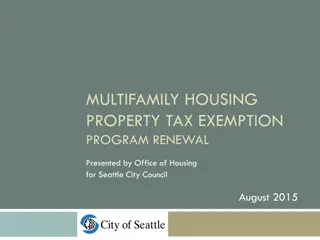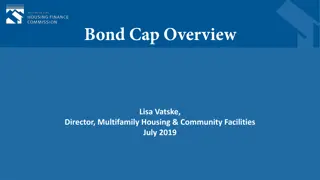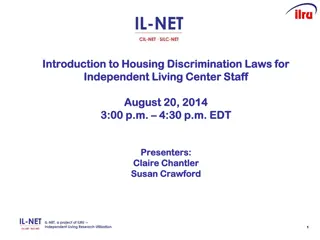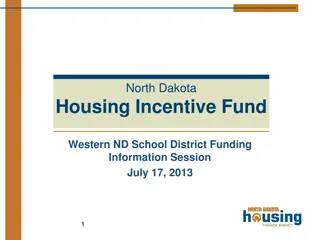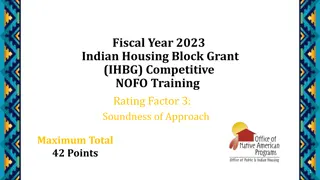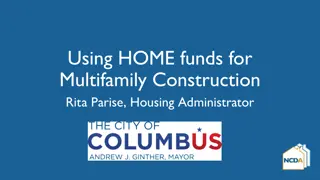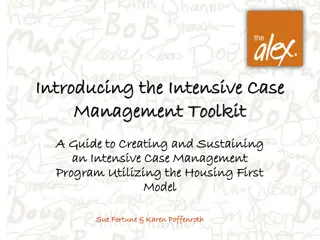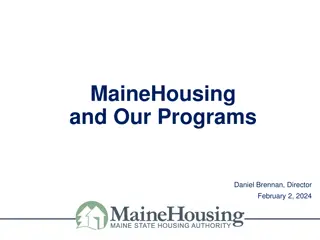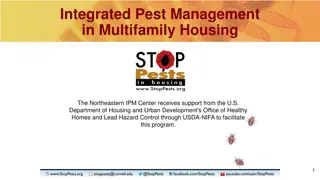Overview of Multifamily Housing and Healthcare Programs Training
This training session covered topics such as the regulation overview, new rules in CFR part 200, and the processing guide for previous participation review. It emphasized the importance of reviewing controlling participants' involvement in projects and introduced new certification processes for entities. The presented images and descriptions provided insights into regulatory changes and procedural updates affecting multifamily housing and healthcare programs.
Download Presentation

Please find below an Image/Link to download the presentation.
The content on the website is provided AS IS for your information and personal use only. It may not be sold, licensed, or shared on other websites without obtaining consent from the author. Download presentation by click this link. If you encounter any issues during the download, it is possible that the publisher has removed the file from their server.
E N D
Presentation Transcript
Previous Participation Training Presented by: Office of Multifamily Housing, Office of Healthcare Programs and Office of General Counsel 1
Overview of Regulation Text Kathie Soroka, Office of General Counsel 2
New Rule 24 CFR part 200, subpart H (24 CFR 200.210 222) Purpose: HUD wants to check the Previous Participation of the Individuals and Entities in control of our projects. 3
New Rule Supersedes Previous Regulation 200.220: Upon the occurrence of a Triggering Event the Commissioner shall review the Previous Participation of the relevant Controlling Participants in considering whether to approve [their] participation There is a Reconsideration Process Specific details are in the Processing Guide 4
Overview of Processing Guide Housing Notice 2016-15 Sara Bergen, Office of Multifamily Housing 5
Processing Guide One Stop Shop for Previous Participation Review Guidance 30 Day Comment Period before HUD can make substantive changes to the guide New Process: Supersedes and clarifies past practice and guidance Goal: Focus on the people and entities with operational and/or financial control Flags: Updated and standardized 6
Processing Guide Program Applicability Who must file Organization Chart Content How to file Electronic (Preferred) OR Paper Option Flags How risks are to be reviewed New Certification for Limited Liability Investor Entities 7
Identifying Controlling Participants Sara Bergen, Office of Multifamily Housing, Rachel Coleman, Office of Healthcare Programs, and Kathie Soroka, Office of General Counsel 8
Identifying Controlling Participants Key Question: Who has Operational and/or Financial Control? We want submissions for those individuals / entities that exercise control. We don t want all the other noise that distracts us from reviewing the important individuals and entities. Just like now, the first determination is made by the applicant and/or the FHA Lender 9
Identifying Controlling Participants Controlling Participants include: Specified Capacities (entity) Specified Capacities Multifamily Housing Office of Residential Care Facilities X X Office of Hospital Facilities Borrower or Owner Management Agent X X X X Operator General Contractor Construction Manager Master Tenant/Landlord X X X X X X X X Individuals and entities that control the Specified Capacities At least one natural person for each project 10
Who Must File usual suspects Owners of 25% or more of the Specified Capacity Owners of 25% or more of the entity that controls the Specified Capacity Non-profit: Executive Director For-profit corp: members of Board who are also officers of the corp. People and/or Entities listed in non-recourse debt section of Regulatory Agreement Who exercises financial and/or operational control? 11
Who Must File those tricky entities Controlling Stockholders of a corporation Trustees of a Trust REITS: REIT itself and CEO and company officers (except those officers who don t exercise control) 12
Requirement for 242 Program The executive management (Chief Executive Officer, Chief Financial Officer, and Chief Operating Officer, or equivalents) of the Borrower, and Members of the Board of Directors that HUD determines have control over the finances or operation of the hospital (typically the President, Vice President, Treasurer, and Chairman of the Finance Committee, or equivalents). 13
Who does not file? Wholly-Owned Entities and Shell Entities (except the Specified Capacity) Tax Credit Investors LIHTC, new markets, etc. Passive investors they are not exercising control. Minor Officers All members of the Board of Directors Less than 25% Ownership except where they re being tricky Nursing Home Administrators Non-controlling Shareholders of Publicly Traded Companies Mortgagees Public Housing Agencies Individuals or entities that do not exercise financial or operational control. 14
Organization Charts Visual representation of the ownership structure of an organization Separate chart submitted for each Specified Capacity KeyPoint: Clear enough for someone unfamiliar with the project and entities involved to understand ownership and control structure. 15
Organizational Charts Not everyone listed on the Org Chart must file a Previous Participation submission The org chart is how we check that the identified Controlling Participants make sense. 16
Organization Charts Show all tiers of ownership structure including members or owners of the entities listed. Show all participants, not just controlling participants Show percentages of ownership and role in the entity (add up to 100%). At least one natural person 17
Local Housing Non-Profit, Inc. Board of Directors List Indiana Avenue, LLC Borrower Entity Person A, President; Person B, Vice President, Person E, Secretary Person G, President Person H, Vice-President Person I, Secretary Person J, Treasurer Person K, Board Member Person L, Board Member Person M, Board Member Person N, Board Member Local Developer, Inc. Local Housing Non-Profit, Inc. 80% managing member 20% Member Person A, President, Person B, Vice President Person F, Executive Director Who Must File? Specified Capacity: Controlling Participants: Indiana Avenue, LLC Person A Person B Person D Person C Person A 20% Member Person B 10% Member Excluded Parties Person/Entity 10% Managing Member No Authority over day-to-day operations 55% Member No Authority over day- to-day operations Reason for Exclusion Local Housing Non-Profit, Inc. Local Developer, Inc. Person C Person D Persons G-N No authority over day-to-day operations Shell entity No authority over day-to-day operations No authority over day-to-day operations No authority over day-to-day operations 18
Atlantic Avenue Limited Partnership President Person F B&O GP I, LLC Money bags SLP, LLC 0% Special Limited Partner Money bags Equity Fund, LP 99.99% Limited Partner and LLCI Illinois Avenue GP II, LLC 0.0065% Managing GP Person C, President, Person D, Vice President, Person F, Secretary 0.0035% Non-Managing GP; No day-to-day control Person A, President, Person B, Secretary Baltic Avenue, LLC 20 % Member Connecticut Avenue Management II, LLC 80% Member and Manager Person F, President Affordable Housing Foundation Inc. Non-Profit 100% Owner Person AA, Executive Director See Attached Board of Director's List Person H, President, Person I, Vice President, Person J, Secretary Affordable Housing Foundation, Inc. Board of Directors List Person BB, President Person CC, Vice-President Person DD, Secretary Person EE, Treasurer Person FF, Board Member Person GG, Board Member Person HH, Board Member Person II, Board Member Person G Person F 50% 50% Managing Member Managing Member Person E Person A Person B 30 % Member Person C Person D Manager and 80% Member 20% Managing Member 10 % Member 20 % Member
Who Must File? Specified Capacity: Atlantic Aveune Limited Partnership Controlling Participants:Connecticut Avenue Management II, LLC Person F Person G Excluded Parties Person/Entity Reason for Exclusion B&O GP I, LLC No authority over day-to-day operations Baltic Avenue, LLC Shell Entity Illinois Avenue GP II, LLC No authority over day-to-day operations Affordable Housing Foundation, Inc. No authority over day-to-day operations Board of Directors Person A Person B Person C Person D Person E Moneybags SLP, LLC Special Limited Partner No authority over day-to-day operations No authority over day-to-day operations No authority over day-to-day operations No authority over day-to-day operations No authority over day-to-day operations No authority over day-to-day operations LLCI Certification: Money Bags Equity Fund, LP 21
Marvin Gardens, LLC Person A, President/CEO Park Place, LLC 100% Managing Member Person A, President/CEO Pennsylvania Avenue, Inc. Managing Member, 50% owner, Kentucky Avenue, Inc. 50% Member, person B, President/CEO Person A, President/CEO Person B Person C Person A 25% Shareholder; No Day-to-Day Control 25% Shareholder; No Day-to-Day Control Controlling member 50% Shareholder 22
Virginia Avenue, LLC Who Must File? Person A, President, Person B, Vice- President, Person C, Secretary Specified Capacity: Virginia Avenue, LLC Controlling Participants: Person A St. James Place, LLC 100% Member Person A, President, Person B, Vice- President, Person C, Secretary Excluded Parties Person/Entity Reason for Exclusion North Carolina Avenue, LLC St. James Place, LLC Pacific Avenue, LLC Pacific Avenue, LLC 1% Managing Member Person A, President and 100% Managing Member Wholly-owned entities 99% Investor Member Person B, CFO, Person C, President, Person D, Vice-President North Carolina Avenue, LLC Vermont Avenue LP, Vermont Avenue Partner LLC, No authority over day-to-day operations Shell entity & No control Vermont Avenue Limited partnership 100% Sole Member Person B, CFO, Person C, President, Person D, Vice-President Atlantic Avenue REIT, Inc. No authority over day-to-day operations Person A, 100% Managing Member Atlantic Avenue REIT GP, Inc. No authority over day-to-day operations Vermont Avenue Partner, LLC Atlantic Avenue REIT GP, Inc. 99% Limited Partner Person C, Key Principal 1% General Partner Person C, Key Principal Atlantic Avenue REIT, Inc. Sole Member Person C 23
Questions/Comments Multifamily Housing Projects MF_PreviousParticipation@hud.gov Office of Residential Care Facilities (232 Program) LeanThinking@hud.gov Office of Hospital Facilities (242 Program) Hospitals@hud.gov 24
Flags in the Active Partners Performance System (APPS) Jen Larson, Office of Multifamily Housing & Rita Dockery, Office of Healthcare Programs 25
Flags - the basics Three Tiers Flags are used to assess risk associated with a participant Flags do not automatically exclude a participant HUD: do not place flags for minor infractions (Processing Guide details what to consider and when Branch Chiefs and Directors of Asset Management have discretion to correct flags) 26
Flags good to know Flagged participants will be notified in writing APPS system will include detailed internal comments related to the flag for use by future HUD staff -- let s not start from square 1 every time! Previous participation is just one part of the overall review (application, underwriting, etc.) 27
Tier 3 Flags: Temporary Risk Relate to a single and/or less serious incident of non- compliance Flags can be removed when non-compliance is resolved Examples of Tier 3 Flags: Failure to File Financial Statements Unacceptable Physical Condition Unsatisfactory Management Review Unauthorized Distributions 28
Tier 3 Flags: Temporary Risk Example Project A did not file their Annual Financial Statements (AFS) by the deadline Automatic Tier 3 flag Referred to Departmental Enforcement Center (DEC) If AFS filed, Flag Resolved If AFS not filed, Further Enforcement Action 29
Tier 3 Flags: Temporary Risk Example Project A got a REAC Inspection score of 25c Flagged with a Tier 3 Flag for Unacceptable Physical Condition Referred to Departmental Enforcement Center (DEC) and Notice of Violation/Default sent out Owner has 60 days to make all repairs Property re-inspection after 60 days If REAC score > 60; Flag Removed If REAC score < 60; Tier 2 Flag AND additional enforcement 30
Tier 2 Flags: Compliance Risk Compliance Risk Flags remain for a period of time as a risk factor even if underlying issue is resolved Examples of Tier 2 Flags: Repeated Failure to File Annual Financial Statements (AFS) Unacceptable Physical Condition Conversion to an Unapproved Use Unauthorized Change in Participant Repeated Unresolved Audit Findings 31
Tier 2 Flags: Compliance Risk Example Controlling Participant of Projects A, B and C doesn t file AFS by the Deadline AND does not respond to HUD correspondence. 3 Tier 3 flags placed automatically (one for each project) Removed when AFS filed Tier 2 Flag Placed Retained for 5 years even if AFS filed Additional Enforcement Actions 32
Tier 2 Flag: Compliance Risk Example Controlling Participant of Project D files AFS 90+ days late for 3 years in a row Tier 3 flag placed each year Removed each year when AFS filed Tier 2 flag placed in year 3 Retained for 5 years even if AFS filed Additional Enforcement Actions 33
Tier 2 Flag: Compliance Risk Example Controlling Participant of Project E takes unauthorized distributions for 3 years in a row Tier 3 flag placed each year Removed each year when distributions repaid Tier 2 flag placed in year 3 Retained for 5 years even if distributions repaid Additional Enforcement Actions possible 34
Tier 1 Flags: Elevated Risk Significant Long-Term Risk Warrant significant mitigation Permanent Flags Examples of Tier 1 Flags: Mortgage Assignment FHA Claim Suspension or Debarment Current or Past Conviction of Fraud or Embezzlement of Funds 35
Tier 1 Flags: Elevated Risk Examples Controlling Participant of Project A submitted fraudulent information during underwriting resulting in mortgage assignment Tier 1 permanent flag for Mortgage Assignment Tier 1 permanent flag for Fraud Conviction Additional Enforcement Actions 36
Tier 1 Flags: Elevated Risk Examples Controlling Participant of Project B violates the HAP contract by neglecting the property and using project assets for personal gain Project B is referred to Property Disposition for Foreclosure to be sold at auction Tier 1 permanent flag placed Additional Enforcement Actions 37
Review of Participants Jen Larson, Office of Multifamily Housing, Kendall Allen, Office of Multifamily Housing & Rachel Coleman, Office of Healthcare Programs 38
HUDs Options Approve Condition Approval Limit participation Disapprove Note: The Processing Guide lays out the process for a request for reconsideration of a disapproval. 39
Reviewing Participants with No Flags If there are No flags in the APPS system AND The applicant is able to make all certifications The Previous Participation Review is considered complete NOTE: Previous Participation approval does not mean other reviews (eg, underwriting, etc.) are approved! 40
Reviewing Participants with Current Flags If there are current flags in the system, HUD will review: Comments in the system related to the flag Lender or Participant s explanation and mitigation Whether flags need to be resolved The flag history to assess patterns of misconduct/risk to the Department 41
Reviewing Tier 3 Flags: Temporary Risk Participants may be approved if: Conditions in the Approval Conditions column are met. REAC Score Example: Project A receives a REAC score of 50 (second consecutive below 60). Controlling Participants in project A is flagged until Project A receives a REAC inspection score over 59 on a subsequent inspection. Controlling Participants in Project A would like to do new business with HUD in Project B. HUD can approve their participation in Project B if the flagged participants certify that 100% of the units in Project A have been inspected and all physical deficiencies have been remedied. 42
Tier 3 Flag Example: Failure to File Financial Statements Project A has not filed the annual financial statements (AFS) by the deadline. Controlling Participants in Project A have received automatic flags. Controlling Participants in Project A would like to participate in Project B. When the AFS are filed, HUD will remove the flags and may approve participation in Project B. NOTE: HUD will remove this flag when missing AFS have been submitted or 5 years after the placement date of the flag, whichever is sooner. 43
Tier 3 Flag Example: Unauthorized Distributions Controlling Participants in Project A have taken unauthorized distributions Tier 3 flags placed Controlling Participants in Project A would like to participate in Project B. When evidence that the unauthorized distributions have been repaid is provided, HUD will remove the flags and may approve participation in Project B. NOTE: HUD will remove this flag when the unauthorized distributions have been repaid or 5 years after the placement date of the flag, whichever is sooner. 44
Tier 2 Flags: Compliance Risk Participants may be approved if: HUD determines that, because the participant has sufficiently improved operations and oversight to ensure that further violations will not occur or for other compelling reasons, the flag is not indicative of ongoing risk. 45
Tier 2 Flag Example: Unauthorized Distributions Controlling Participants in Project A took unauthorized distributions in 2013 and 2014. These same Controlling Participants took unauthorized distributions in Projects B and C in 2014 and received a Tier 2 flag. These Controlling Participants repaid all of their unauthorized distributions in 2015. The flag remains for five years as a risk factor. The same Controlling Participants have asked to participate in Project D. 46
Tier 2 Unauthorized Distributions Example (cont.) The controlling participants provide: Evidence that all unauthorized distributions have been repaid for all projects and no unauthorized distributions were taken in 2015. Evidence that a new CFO with significant HUD experience was hired. This CFO has implemented improved financial controls in the form of X, Y and Z to avoid future unauthorized distributions. 47
Tier 2 Unauthorized Distributions Example (cont.) HUD may approve the Controlling Participants to participate in Project D as they have: Resolved the Non-Compliance AND Improved Operations and Oversight to prevent future non-compliance Updating APPS: While the flags will remain for 5 years, HUD will update the flag comments in the APPS system to describe the evidence provided and explain why HUD approved these participants in Project D despite the flags for use by future HUD staff. 48
Tier 1 Flags: Elevated Risk Participants may be approved if: HUD determines that participant has sufficiently improved operations and oversight to ensure further violations will not occur, or for other compelling reasons, the flag is not indicative of ongoing risk. Updating APPS: While the flags will remain, HUD will update the flag comments in the APPS system to describe the evidence provided and explain why HUD approved these participants in despite the flags for use by future HUD staff. 49
Tier 1 Flag Example Property C had two controlling participants (Person A and Person B) when the mortgage was assigned 7 years ago Tier 1 flags were placed on both controlling participants Person B has applied to refinance a project with FHA insurance Person B has demonstrated successful ownership of 20 other projects in the last 5 years including the proposed refinance project Person B has brought in a new partner, Person C with significant positive HUD experience 50





